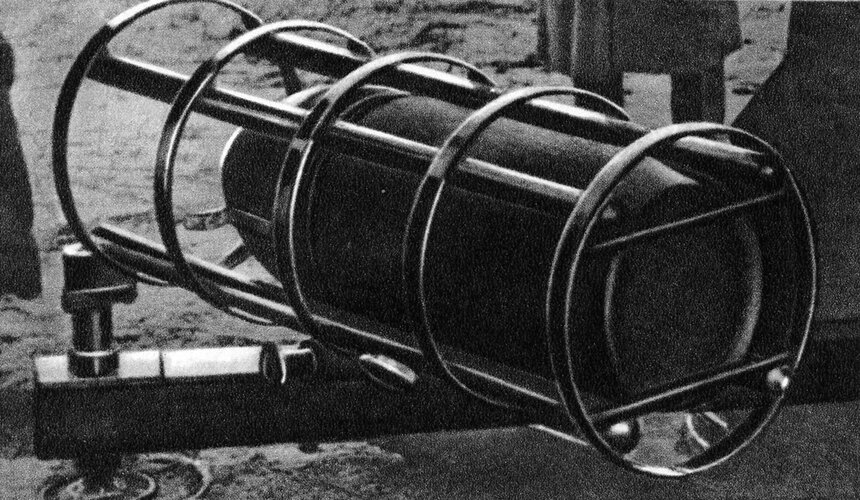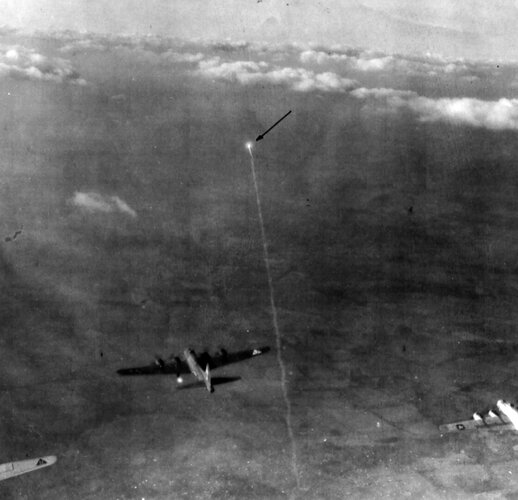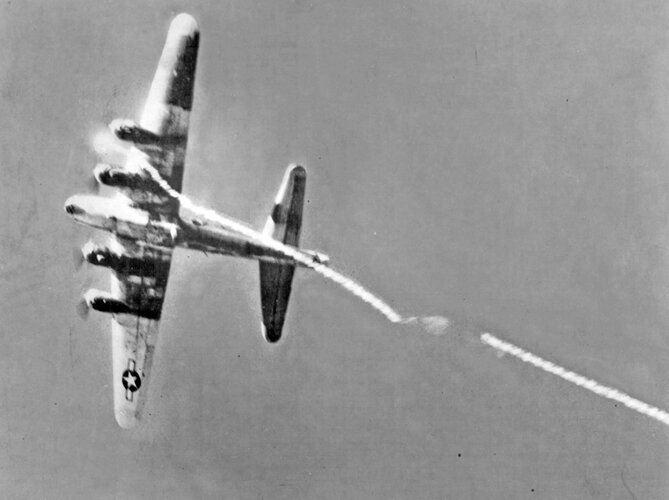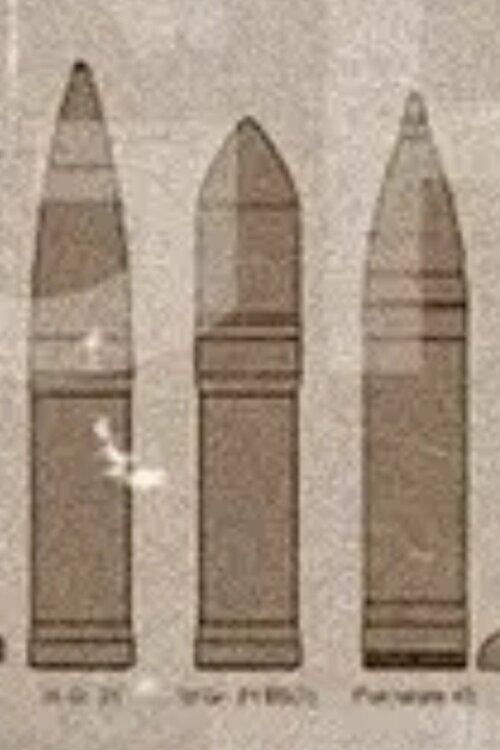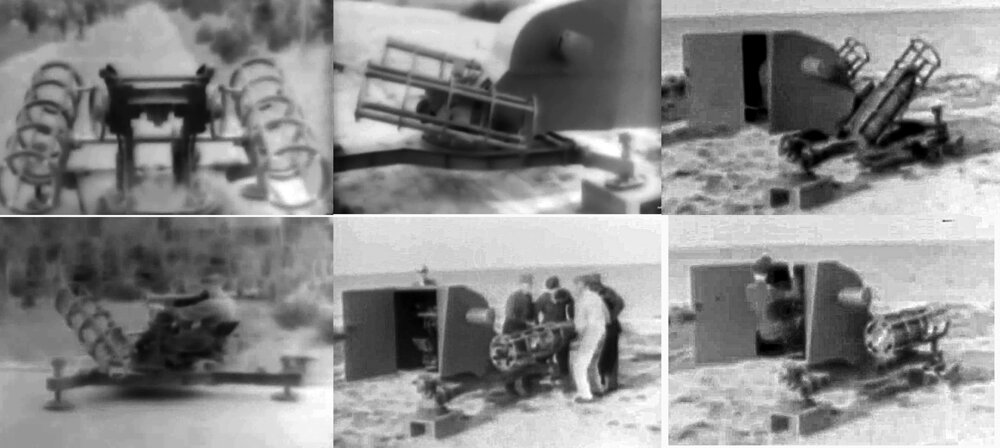The 21cm Maikäfer Flakrakete 42 program stemmed from a Hitler directive in August 1943 to develop an anti-bomber Flak weapon based on the existing 21cm Nebelwerfer artillery rocket according to Gen.der Flak a.D. von Renz’s “Development of German Anti-aircraft Weapons and Equipment of All Types up to 1945” (pp. 349 et passim). The program was a failure, though various Allied intelligence reports do mention the associated rocket. The lingering mystery is the launcher. The old Polish book “Rakety Bojowe” has a photo that appears to show the launch cell, but not the entire launcher. Has anyone seen any photos or drawings of the actual launcher?
You are using an out of date browser. It may not display this or other websites correctly.
You should upgrade or use an alternative browser.
You should upgrade or use an alternative browser.
21cm Maikäfer Flakrakete 42
- Thread starter Abingdon
- Start date
Grzesio
ACCESS: Secret
The rocket illustrated in "Rakiety bojowe" is not the Flakrakete 42.
Development of AA rockets with 7000 m ceiling was first started and funded already in 1932 IIRC, and was revived in 1943 as the first of three stages of an AA missile development program.
The drawing below shows 21 cm Wgr 42 Spr on the left, Flakrakete 42 on the right.
Development of AA rockets with 7000 m ceiling was first started and funded already in 1932 IIRC, and was revived in 1943 as the first of three stages of an AA missile development program.
The drawing below shows 21 cm Wgr 42 Spr on the left, Flakrakete 42 on the right.
Attachments
T. A. Gardner
ACCESS: Top Secret
- Joined
- 18 February 2021
- Messages
- 1,016
- Reaction score
- 1,759
Scott Kenny
ACCESS: Above Top Secret
- Joined
- 15 May 2023
- Messages
- 8,529
- Reaction score
- 9,194
Looks like the 2cm Flak38 trailer/mount.
Grzesio
ACCESS: Secret
It is much bigger, more similar to the 3,7 cm Flak carriages, but still different.
Generally the weapon perfectly fits of the original concept of the Stoelzel AA launcher, except it fires two rockets instead of four.
Maikaefer is generally a very obscured rocket - according to Hahn it was an artillery rocket, 31 cm in calibre, 158 kg heavy, had a 24 kg heavy Triebwerk, velocity of 170 m/s and 2940 m range. I wonder, what this "Triebwerk" actually was - some 14-15 kg of solid propellant is needed to accelerate a 158 kg rocket to 170 m/s and in this case 24 kg is too little for a complete engine, but maybe it is the weight of an empty engine.
However, according to Emde and Dornberger, Stoelzel used 28 cm Wk. Spr. rockets with time fuzes for his trials - but maybe a more powerful rocket, possibly a Maikaefer? - was used at a later date.
Generally the weapon perfectly fits of the original concept of the Stoelzel AA launcher, except it fires two rockets instead of four.
Maikaefer is generally a very obscured rocket - according to Hahn it was an artillery rocket, 31 cm in calibre, 158 kg heavy, had a 24 kg heavy Triebwerk, velocity of 170 m/s and 2940 m range. I wonder, what this "Triebwerk" actually was - some 14-15 kg of solid propellant is needed to accelerate a 158 kg rocket to 170 m/s and in this case 24 kg is too little for a complete engine, but maybe it is the weight of an empty engine.
However, according to Emde and Dornberger, Stoelzel used 28 cm Wk. Spr. rockets with time fuzes for his trials - but maybe a more powerful rocket, possibly a Maikaefer? - was used at a later date.
Attachments
Last edited:
T. A. Gardner
ACCESS: Top Secret
- Joined
- 18 February 2021
- Messages
- 1,016
- Reaction score
- 1,759
24 kg is likely the weight of the charge of Diglycol since that would be the propellant used. Germany was well advanced in liquid fuel rocket engine technology but by 1944 was woefully behind in solid fuel developments.It is much bigger, more similar to the 3,7 cm Flak carriages, but still different.
Generally the weapon perfectly fits of the original concept of the Stoelzel AA launcher, except it fires two rockets instead of four.
Maikaefer is generally a very obscured rocket - according to Hahn it was an artillery rocket, 31 cm in calibre, 158 kg heavy, had a 24 kg heavy Triebwerk, velocity of 170 m/s and 2940 m range. I wonder, what this "Triebwerk" actually was - some 14-15 kg of solid propellant is needed to accelerate a 158 kg rocket to 170 m/s and in this case 24 kg is too little for a complete engine, but maybe it is the weight of an empty engine.
However, according to Emde and Dornberger, Stoelzel used 28 cm Wk. Spr. rockets with time fuzes for his trials - but maybe a more powerful rocket, possibly a Maikaefer? - was used at a later date.
Grzesio
ACCESS: Secret
A 158 kg heavy rocket with 24 kg of diglycol propellant would reach velocity somewhere around 280 m/s. So either the Maikaefer's velocity wasn't 170 m/s, either 24 kg is not the fuel weight.24 kg is likely the weight of the charge of Diglycol since that would be the propellant used.
T. A. Gardner
ACCESS: Top Secret
- Joined
- 18 February 2021
- Messages
- 1,016
- Reaction score
- 1,759
I'd think that'd depend on the exact composition of the diglycol. The Germans could and did vary the burn rate so it is possible they used additives to slow the burn down and give it a longer burn time to get more range.A 158 kg heavy rocket with 24 kg of diglycol propellant would reach velocity somewhere around 280 m/s. So either the Maikaefer's velocity wasn't 170 m/s, either 24 kg is not the fuel weight.
Grzesio
ACCESS: Secret
Burn rate is adjusted by appropriate shaping of the fuel sticks rather than by changing fuel composition. German solid fuelled rockets had burning time around 1-2 s, what corresponded to some 100-300 m of active trajectory section - so difference in range was really negligible.
Then, max. velocity of a rocket depends just on total impulse of the engine - a rocket with slow burning engine accelerates slower but in a longer time than a rocket with a fast burning engine, accelerating faster but in a shorter time - thus both rockets will reach similar max. velocity. And so if 24 kg is the fuel weight, 170 m/s cannot be Maikaefer's max. velocity - and vice versa.
Then, max. velocity of a rocket depends just on total impulse of the engine - a rocket with slow burning engine accelerates slower but in a longer time than a rocket with a fast burning engine, accelerating faster but in a shorter time - thus both rockets will reach similar max. velocity. And so if 24 kg is the fuel weight, 170 m/s cannot be Maikaefer's max. velocity - and vice versa.
Similar threads
-
Panzerblitz and Panzerschreck puzzle
- Started by Grzesio
- Replies: 64
-
-
Henschel Hs 293 developments and projects
- Started by Jemiba
- Replies: 16
-
-

